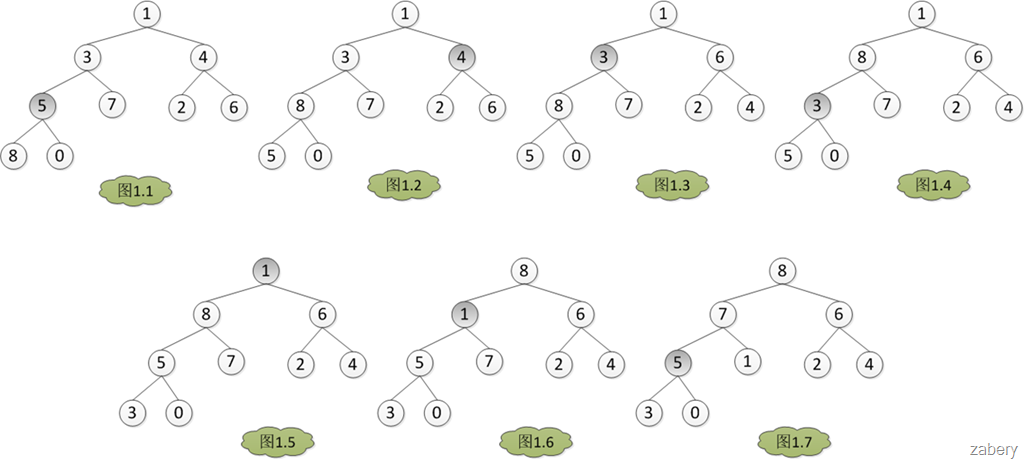堆排序
来源:互联网 发布:盲人阅读器小说软件 编辑:程序博客网 时间:2024/05/23 17:30
1.堆的概念
参考:http://www.cnblogs.com/luchen927/archive/2012/03/08/2381446.html
堆(heap),一种数据结构,堆分为最大堆和最小堆,其实就是完全二叉树。最大堆要求节点的元素都要大于其孩子,最小堆要求节点元素都小于其左右孩子,两者对左右孩子的大小关系不做任何要求,其实很好理解。有了上面的定义,我们可以得知,处于最大堆的根节点的元素一定是这个堆中的最大值。其实我们的堆排序算法就是抓住了堆的这一特点,每次都取堆顶的元素,将其放在序列最后面,然后将剩余的元素重新调整为最大堆,依次类推,最终得到排序的序列。
或者说,堆排序将所有的待排序数据分为两部分,无序区和有序区。无序区也就是前面的最大堆数据,有序区是每次将堆顶元素放到最后排列而成的序列。每一次堆排序过程都是有序区元素个数增加,无序区元素个数减少的过程。当无序区元素个数为1时,堆排序就完成了。
本质上讲,堆排序是一种选择排序,每次都选择堆中最大的元素进行排序。只不过堆排序选择元素的方法更为先进,时间复杂度更低,效率更高。
堆排序过程
堆分为大根堆和小根堆,是完全二叉树。大根堆的要求是每个节点的值都不大于其父节点的值,即A[PARENT[i]] >= A[i]。在数组的非降序排序中,需要使用的就是大根堆,因为根据大根堆的要求可知,最大的值一定在堆顶。
既然是堆排序,自然需要先建立一个堆,而建堆的核心内容是调整堆,使二叉树满足堆的定义(每个节点的值都不大于其父节点的值)。调堆的过程应该从最后一个非叶子节点开始,假设有数组A = {1, 3, 4, 5, 7, 2, 6, 8, 0}。那么调堆的过程如下图,数组下标从0开始,A[3] = 5开始。分别与左孩子和右孩子比较大小,如果A[3]最大,则不用调整,否则和孩子中的值最大的一个交换位置,在图1中是A[7] > A[3] > A[8],所以A[3]与A[7]对换,从图1.1转到图1.2。 
调堆:如果初始数组是非降序排序,那么就不需要调堆,直接就满足堆的定义,此为最好情况,运行时间为Θ(1);如果初始数组是如图1.5,只有A[0] = 1不满足堆的定义,经过与子节点的比较调整到图1.6,但是图1.6仍然不满足堆的定义,所以要递归调整,一直到满足堆的定义或者到堆底为止。如果递归调堆到堆底才结束,那么是最坏情况,运行时间为O(h) (h为需要调整的节点的高度,堆底高度为0,堆顶高度为floor(logn) )。
建堆完成之后,堆如图1.7是个大根堆。将A[0] = 8 与 A[heapLen-1]交换,然后heapLen减一,如图2.1,然后AdjustHeap(A, heapLen-1, 0),如图2.2。如此交换堆的第一个元
素和堆的最后一个元素,然后堆的大小heapLen减一,对堆的大小为heapLen的堆进行调堆,如此循环,直到heapLen == 1时停止,最后得出结果如图3。 
2.堆的性质维护
2.二叉堆性质维护问题描述
•
输入:数组A[1…n]存储的一棵几乎完全二叉树,正整数i。其中以A[i]为根的子树中,A[i]的两个孩子已构成最大堆。
•
输出:数组A。其中,以A[i]为根的子树中的节点布局有所变动构成最大堆。
2.1 堆性质维护算法的伪代码描述
MAX-HEAPIFY(A, i)//运行时间(lgn)1 l ← LEFT(i)2 r ← RIGHT(i)3 if l ≤ heap-size[A] and A[l] > A[i]4 then largest ← l5 else largest ← i6 if r ≤ heap-size[A] and A[r] > A[largest]7 then largest ← r8 if largest ≠ i9 then exchange A[i] ↔ A[largest]10 MAX-HEAPIFY(A, largest)3.二叉堆创建问题描述
•输入:数组A[1…n]。
•输出:重排后的数组A[1…n],元素间构成一个堆。
3.1 创建堆算法的伪代码描述
利用过程MAX-HEAPIFY以自底向上的方式将数组A[1……n]转换为一个最大堆。由于子数组A[[n/2]+1…..n]的每一个元素都没有左右孩子,所以都是树的叶子,因此每一个觉构成一个单元素堆。过程BUILD-MAX-HEAP检测树中的其余节点并对每个节点运行MAX-HEAPIFY。
BUILD-MAX-HEAP(A)1 heap-size[A] ← length[A]2 for i ← length[A]/2 downto 13 do MAX-HEAPIFY(A, i)BUILD-MAX-HEAP运行的一个例子:
堆创建算法的运行时间:o(nlgn).
4 程序实现
4.1(C语版本)
#include <stdlib#include "heap.h"#include "swap.h"/**************堆排序相关算法********************/// i:给定的节点下标int left(int i)//左孩子下标{return 2 * i + 1;}int right(int i)//右孩子下标{return 2 * i + 2;}int parent(int i)//父节点下标{return (i - 1) / 2;}/***************************函数:heapify功能:堆性质维护输入参数:a :序列数组size:数据类型所占字节i:待维护节点下标heapsize:堆中元素个数*comp:比较函数,以便实现最大堆和最小堆的通用算法****************************/void heapify(void *a, int size, int i, int heapsize, int(*comp)(void*, void*)){int l = left(i), r = right(i), most;//most: A[I],A[l],A[r]中的最大或最小if (l < heapsize&&comp((char*)a + l*size, (char*)a + i*size)>0)//l<heapsize且A[i]<A[l]most = l;//根节点大于左孩子elsemost = i;if (r < heapsize&&comp((char*)a + r*size, (char*)a + most*size)>0)//r<heapsize且A[r]>A[most]most = r;if (most != i)//i不是最大或最小节点,则元素位置调换,使其 满足堆的性质{swap((char*)a + i*size, (char*)a + most*size, size);heapify(a, size, most, heapsize, comp);//递归检测}}/***************************函数:buildHeap功能:建堆输入参数:a :序列数组size:数据类型所占字节length:数组中元素个数*comp:比较函数,以便实现最大堆和最小堆的通用算法****************************/void buildHeap(void*a, int size, int length, int(*comp)(void*, void*)){int i;//循环控制变量循环检测节点性质并维护for (i = (length / 2) - 1; i >= 0; i--)heapify(a, size, i, length, comp);}/***************************函数:heapSort功能:堆排序输入参数:a :序列数组size:数据类型所占字节length:数组中元素个数*comp:比较函数,以便实现最大堆和最小堆的通用算法****************************/void heapSort(void*a, int size, int n, int(*comp)(void*, void*)){ int i,heapsize=n;//循环控制变量循环检测节点性质并维护 buildHeap(a, size, n, comp); for (i = heapsize - 1; i >= 0; i--) { swap((char*)a + i*size, (char*)a, size); //a[0]<->a[i] heapsize--; heapify(a, size, 0, heapsize, comp); }}建堆测试:
#include <stdio.h>#include <stdlib.h>#include"compare.h"#include "sort.h"#include"merge.h"#include "partition.h"#include "heap.h"int main(int argc, char** argv){ int b[] = { 4,1,3,2,16,9,10,14,8,7 }, i; buildHeap(b, sizeof(int),10, intGreater); printf("max heap:\n"); for (i = 0; i < 10; i++) printf("%d ", b[i]); printf("\n"); buildHeap(b, sizeof(int), 10, intLess); printf("min heap:\n"); for (i = 0; i < 10; i++) printf("%d ", b[i]); printf("\n"); system("pause"); return EXIT_SUCCESS;}堆排序测试:
int main(int argc, char** argv){ int b[] = { 4, 1, 3, 2, 16, 9, 10, 14, 8, 7 }, i; heapSort(b, sizeof(int), 10, intGreater); printf("max heap sort:\n"); for (i = 0; i < 10; i++) printf("%d ", b[i]); printf("\n"); heapSort(b, sizeof(int), 10, intLess); printf("min heap sort:\n"); for (i = 0; i < 10; i++) printf("%d ", b[i]); printf("\n"); system("pause"); return EXIT_SUCCESS;}4.2 (C++版)
#ifndef _HEAP_H#define _HEAP_Hint left(int i){ return 2 * i + 1;}int right(int i){ return 2 * i + 2;}int parent(int i){ return (i - 1) / 2;}template<typename Iterator,typename Comparator>void heapify(Iterator _first, Iterator _last, int i, Comparator comp){ int l = left(i), r = right(i), most; int n = distance(_first, _last); if (l < n&&comp(*(_first + l), *(_first + i))>0) most = l; else most = i; if (r < n&&comp(*(_first + r), *(_first + most))>0) most = r; if (most!=i) { iter_swap(_first + i, _first + most); heapify(_first, _last, most, comp); }}template<typename Iterator,typename Comparator>void buildHeap(Iterator _first, Iterator _last, Comparator comp){ int n=distance(_first,_last),i; for (i = n / 2 - 1; i >= 0;i--) { heapify(_first, _last, i, comp); }}/**************堆排序*************************/template<typename Iterator, typename Comparator>void heapSort(Iterator _first, Iterator _last, Comparator comp){ buildHeap(_first, _last, comp); Iterator k; for (k = _last-1; k != _first; k--) { iter_swap(k, _first);//a[0]<->a[i] heapify(_first, k, 0, comp); }}#endif建堆测试:
#include "stdafx.h"#include<string.h>#include <stdlib.h>#include <vector>#include <iterator>#include <iostream>#include<algorithm>#include <functional>//定义运算函数(代替运算符)#include "heap.h"using namespace std;int main(int argc, _TCHAR* argv[]){int a[]={4,1,3,2,16,9,10,14,8,7};vector<int> va = vector<int>(a, a + 10);//用数组创建vector对象buildHeap(va.begin(), va.end(), greater<int>());cout << "max heap:" << endl;copy(va.begin(), va.end(), ostream_iterator<int>(cout, " "));buildHeap(va.begin(), va.end(), less<int>());cout << endl;cout << "min heap:" << endl;copy(va.begin(), va.end(), ostream_iterator<int>(cout, " "));//make_heap(va.begin(),va.end(),greater<int());//STL 堆操作函数//copy(va.begin(), va.end(), ostream_iterator<int>(cout, " "));system("pause");return 0;}运行结果:
堆排序测试:
#include "stdafx.h"#include<string.h>#include <stdlib.h>#include <vector>#include <iterator>#include <iostream>#include<algorithm>#include <functional>//定义运算函数(代替运算符)#include "sort.h"#include "merge.h"#include "partition.h"#include "heap.h"using namespace std;int main(int argc, _TCHAR* argv[]){int a[]={4,1,3,2,16,9,10,14,8,7};vector<int> va = vector<int>(a, a + 10);//用数组创建vector对象heapSort(va.begin(), va.end(), less<int>());cout << "min heap sort:" << endl;copy(va.begin(), va.end(), ostream_iterator<int>(cout, " "));cout << endl;heapSort(va.begin(), va.end(), greater<int>());cout << "max heap sort:" << endl;copy(va.begin(), va.end(), ostream_iterator<int>(cout, " "));//make_heap(va.begin(), va.end(), greater<int>());//STL 堆操作函数//copy(va.begin(), va.end(), ostream_iterator<int>(cout, " "));//cout << endl;//sort_heap(va.begin(), va.end(), greater<int>());//cout << "max heap sort:" << endl;//copy(va.begin(), va.end(), ostream_iterator<int>(cout, " "));system("pause");return 0;}- 堆及堆排序
- 堆/堆排序特点
- 【二叉堆、堆排序】
- 二叉堆 & 堆排序
- 二叉堆 & 堆排序
- 堆与堆排序
- 堆与堆排序
- 堆与堆排序
- 堆与堆排序
- 堆与堆排序
- 堆与堆排序
- 堆和堆排序
- 堆排序(最大堆)
- 堆和堆排序
- 堆和堆排序
- 堆及堆排序
- 堆和堆排序
- 堆与堆排序
- Length of Last Word
- Android手工测试的代码覆盖率
- 手把手教你做智能手环
- iOS UItableView可以编辑
- Android一点 ListView显示多种布局
- 堆排序
- cookie的path值的默认规则
- ios uiwebview 详解
- 【Servlet】Servlet3.0与纯javascript通过Ajax交互
- PHP 之局部变量与全局变量的交错(一)嵌套for循环中的变量
- offline页面开发常用方法及页面控件验证
- final的使用
- Ubuntu下配置php扩展memcache
- 优化MyEclipse设置,提高运行效率




